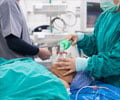While studying fruit flies, researchers from Germany’s University Hospital Schleswig-Holstein, Campus Kiel have found a genetic mutation that might explain how volatile anesthetics work.
Volatile anesthetics are those that easily pass from the liquid to vapour phase and are readily inhaled. These inhaled anesthetics produce profound unconsciousness and are used for patients undergoing many different types of surgical procedures."Despite the widespread use of volatile anesthetics in medical practice, the specific mechanisms of action of inhalational anesthetic agents remain largely unknown," said lead researcher Berthold Bein.
"This hampers efforts to make general anesthesia more individually tailored, more effective and more convenient for the patient," he added.
According to Bein, at present, anesthetic dosing recommendations are based on expert knowledge, which in turn depends on patient characteristics such as age and weight.
Specific understanding of genetic factors that affect anesthetic requirements in humans could dramatically change the way anesthesia is given.
The researchers said that studying tiny Drosphila, which has more in common with humans could offer important clues for eventual scientific breakthroughs in humans.
Advertisement
During the study, the researchers isolated the so-called "Shaker" gene in Drosphila, which is responsible for regulating its extremely short-sleeping patterns.
Advertisement
"We hypothesized that short-sleeping Drosphila mutants also would need increased concentrations of volatile anesthetics, thereby showing a common molecular target responsible for the similar, albeit different physiological states of ’sleep’ and ’anesthesia.’ This hypothesis was proven in our experiment."
It is the first study to demonstrate a link between sleep and anesthesia on a molecular level and that a single-gene mutation can have a drastic impact on susceptibility to volatile anesthetics.
The study’s applicability to humans may not be far off.
"For the first time, we have shown that sleep and anesthesia share a common molecular target. We and other researchers have previously demonstrated that this molecular target has been highly preserved during evolution and is nearly equally present in Drosphila and mammals, including humans," said Dr. Bein.
"More important, these genetic insights may explain, at least in part, differing anesthetic requirements of patients throughout the world and may therefore help to enable individually tailored anesthetic delivery," he added.
The study is published in Anesthesiology.
Source-ANI
PRI/S














